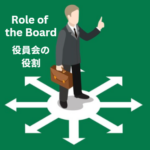In October, the stock market was in step with the U.S. stock market, which rose and fell in response to changes in U.S. long-term interest rates, and after a decline at the beginning of the month and a rebound in the middle of the month, the stock market was in a selling trend toward the end of the month.
The CG Top 20 index outperformed the TOPIX and JPX400 indexes for the second consecutive month in October.
Category: Governance
Outside Director Lessons #11: Committees Need Rules

At Livedoor, I soon proposed that we set up committees of the board to oversee the granular matters in areas such as M&A, finance, and so forth, thinking that this would allow us to specialize to some extent, so that not all of us would have to oversee minor details. But since there was little trust between the new outside directors, everyone immediately wanted to be a member of all committees, and it was impossible to deny anyone that opportunity. The end result was simply to make it unnecessary to reflect some important discussions in the formal board minutes, because the “committee” meetings were not actual “board” meetings.
Outside Director Lessons #10: Directors Set Direction

In Livedoor’s case, before I joined the board it seemed clear to me that eventually, the company would most likely have to be liquidated. It had acquired a lot of companies in addition to operating its portal web site, but there were no synergies between them, and there was very little oversight of subsidiaries. It had no strategy, and its brand name had been destroyed. If anything, being affiliated with the Livedoor name actually reduced the value of its businesses and subsidiaries to some extent, in terms of their ability to get business.
Outside Director Lessons #9: Appointing the CEO

If you are ever in the situation I described in “Outside Director Lessons #8” (see link below), here is what you can do. To begin with, in that situation, you might begin before the AGM, by quietly asking the person that investors supposedly want as the new CEO, if he or she really wants the position and why. Being a CEO is always a lot of work, especially if you have other activities. The person may respond without a lot of clarity, or even signal a sort of reluctance. That is vital information.
Outside Director Lessons #8: The Role of the Board

Before Livedoor’s December 2006 AGM, one of the other newly nominated “independent directors”, asked me whether (if elected) I would vote to remove the current CEO. I replied that I could not answer that question, because I was not on the board yet and had no direct knowledge about what was going on inside the company, including the performance of the CEO.
In response, this director candidate responded, “But if the shareholders want that, how can we not fire him?”
Outside Director Lessons #7: If No D&O…Get It Yourself

In my view, at the end of 2006 I had been nominated in the Livedoor proxy materials for the December AGM without my agreement. This was partly because just saying in quick email that one may be “interested” does not mean one has “decided”. But more importantly, two of the conditions I had clearly set forth, which were dependent on Livedoor itself taking action, had not been fulfilled at all: specification of compensation, and assurance of D&O insurance. When I inquired about the latter, I was told by a senior “advisor” at the company that Livedoor had tried to get D&O insurance from more than 20 insurance companies in Japan, and had been turned down by everyone.
Outside Director Lessons #5: Being a Whistleblower Hotline

At one company where I served as an outside director, I was on good relations with several people who served in administrative functions that involved them in working closely with the board secretariat. Of course they all knew my email address.
One day I was asked somewhat secretively to have lunch with one of them. Two persons showed up. They told me that a certain senior manager was was making inappropriate comments to one particular woman, – a form of sexual harassment. The problem was, this senior manager was the head of Planning, was otherwise well-qualified, and was working on a very important transaction at the time.
Outside Director Lessons #4: What is Worse Than the Company Going Under?

Here is an example of the sort of thing that can happen at mid-size companies in Japan. Let’s say that at the time when you join the company as an outside director, the son of the founder is the CEO. The son is an engineer by training, but when his father became too old to lead the company, the son took his place. The son is the nicest, most gentle man in the world, but he does not have enough management experience or the character to serve as a decisive leader at a time of disruptive technological change. It is clear to you that that he will have to step down, and the board will have to find someone from the outside who has more managerial experience and decisiveness.
At that point, your self-appointed job becomes “finding a soft, smooth way to persuade the CEO to step down”.
Outside Director Lessons #3: How Suddenly Companies Can Collapse!

As its sales increased, Alps had financed its growing working capital needs by borrowing from banks. But no bank wanted to be a “main bank” for a small unlisted company any more. So every year or so we added another bank lending us 200 million yen or more, until we had something like six or seven different banks. All of these loans were short-term, and had to be “rolled over” each year.
As long as all the banks rolled over their loans each year, and we were able to find a new bank when we needed it, to the board, everything seemed fine.
Outside Director Lessons #2: My First Experience as an Outside Director

Why do I think director training is so important to Japan’s future? Because I have seen so much of what goes wrong behind the scenes, and the losses and pain that are caused, when boards do not function well here. I have a lot of “scar tissue”, as we say in English. What is really interesting, is how many commonalities there are in the causes for inadequate governance. The size of the company, and its industry, really do not seem to matter. It is the reverse of Tolstoy’s quote, as if “all Japanese boards that succeed do so in a different way, but all boards that fail, do so in the same way” If so, one would think this should make it easier to avoid governance failures.
My first experience as an outside director in Japan began in the year 2000, when the M&A advisory boutique that I led at that time, JTP Corporation, advised the US firm of MapInfo to conclude a strategic alliance and invest in a 25% capital raise by Alps Mapping in Nagoya. Alps (as it was known in Japanese) was an unlisted firm that was the third largest map publisher in Japan, and had excellent map data. The company was planning to go public at some time in the future. Because MapInfo had no staff in Japan at the time, I was nominated by MapInfo to serve on the board of Alps going forward, to protect not only its interests but also those of other shareholders, because MapInfo had no staff in Japan at the time.
